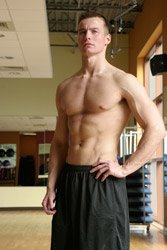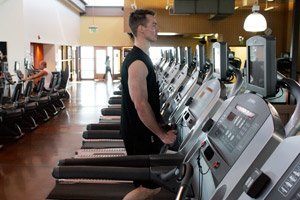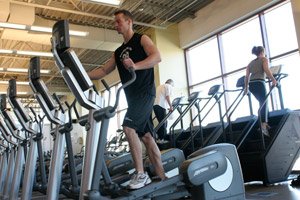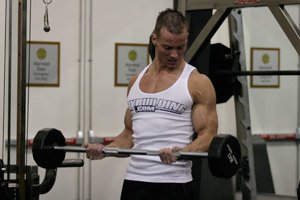The weather is getting warmer and that usually means the clothes reveal more flesh. At this point most of us look at our training and eating habits to shift some of the excess poundage we may be carrying around. Inevitably there's a conundrum over the most effective method for stripping fat.
In determining the effectiveness of any given exercise we have to look at what mechanisms and how they can possibly effect those flabby excesses we want to shift. Basically the following effects from exercise occur in varying levels with different types of exercise.
 Acute Calorie Burn
Acute Calorie Burn 
- When we move it requires energy to do so, as such the more we move the more energy we burn and hopefully some of that energy comes from the fat stored around our bodies. Different degrees of exertion require more or less energy to complete the task and as such some forms of exercise burn fat quicker due to burning more energy.
- After we exercise we might experience a raise in
- as our body burns more energy due to possible tissue remodeling (building new muscle) and the body trying to replace muscle energy stores as well as a slightly stimulated nervous system and
- levels from the exercise. Some forms and intensities of exercise raise the metabolism more than others.
 Morphological Adaptations
Morphological Adaptations 
- Body fat is usually read as a percentage, if we increase the amount of muscle we have and keep our fat levels the same we become leaner as the percentage of our total weight that is fat decreases.
For example say you weigh one-hundred and twenty pounds and have thirty pounds of fat; your body fat is twenty five percent. Now say through exercise we build ten pounds of new muscle and don't put on fat; you will weigh one-hundred and thirty pounds and still have thirty pounds of fat and your body fat would now be only twenty-three percent. In addition you would have a better shape to your body, even though you haven't lost any fat, and you will have become leaner and look better.

 Click Image To Enlarge.
Click Image To Enlarge. If You Increase Your Muscle But Keep Your
Fat Levels The Same, You'll Become Leaner.
Certain exercises are obviously better suited to building muscle than others but this point is often lost on those who are trying to look leaner. In addition muscle requires energy. As such your resting metabolism will increase which means you can eat more food and maintain the same weight, or eat the same food and lose weight quicker.
 P-ratio
P-ratio 
- When we over eat a given amount of food we store it within the body, some people as muscle, and some people as fat but usually a mix of the two. The ratio of what we gain is called the P ratio (P standing for partitioning) and the more we favor storing energy as muscle rather than fat the leaner we will be - increased muscle will increase
- and keeping weight off will be easier.
The P ratio is very dependent on issues like glucose/insulin sensitivity and the circulating anabolic hormones and obviously different forms of exercise will alter these in different manners.
 Appetite Effects
Appetite Effects 
- Obviously fat loss requires we eat less than we expend, if we are eating more than we burn off everyday then we can kiss fat loss goodbye. Exercise can have an effect on our appetite which in turn will either increase or decrease the amount of energy we consume indirectly. This may be a personal matter as some are ravenous of exercise whilst others can't stand the thought of food, but it's worth considering.
 Caveat
Caveat 
- I have just painted a pretty positive picture for exercise in the battle for fat loss but you must realize that without combining a solid
- controlled diet you will more than likely fail in your effort to become leaner - it's becoming clichéd but its true none-the-less - "You can't out-exercise a poor diet."
- Combine the right exercise and a good eating plan and the results can be astounding.

Five Training Methods For Fat Loss
 1. Steady-State Cardiovascular Exercise
1. Steady-State Cardiovascular Exercise 
- Also known as aerobics this form of exercise involves exercising at a continuous submaximal pace for a given time duration. Typically this type of activity involves exercising for around twenty to sixty minutes at an intensity of around sixty to eighty percent of your maximal heart rate.
This type of activity has one major benefit in that it's easy for a low level fitness/overweight individual to burn a reasonable level of calories in a single session. Unless the activity is right at the top end of the intensity range mentioned negligible post exercise raises in metabolism occur.

 Click Image To Enlarge.
Click Image To Enlarge. This Type Of Activity Makes It Easy For An
Individual To Burn A Reasonable Amount Of Calories.
- Changes in body composition through muscle mass increases are negligible and excessive aerobic exercise may have a negative effect long term on muscle mass.
A positive is that low intensity cardiovascular training will improve glucose sensitivity and as such have a positive effect on the P ratio. This means any ingested calories will more likely be stored as glycogen rather than becoming fat. In addition the lower intensity means it can be performed more regularly.
- To maximize cardiovascular training whole-body movements such as
- , rowing and
- performed at an equal intensity will burn more calories than cycling or arm ergometer or other limited muscle movements.
 2. HIIT
2. HIIT 
High Intensity Interval Training
- (HIIT) involves performing bouts of high intensity work alternating with lower intensity activities. An example would be a
- (work), walk (rest) alternation.
The duration of both the work and rest periods can vary as can the prescribed intensities of each and this will alter somewhat the results of the training. Typically 30-60 seconds of max intensity work followed by 60-90 seconds of recovery intensity work is a common method.

 Click Image To Enlarge.
Click Image To Enlarge. HIIT Involves Performing Bouts Of High Intensity
Work Alternating With Lower Intensity Activities.
- Typically the calories burned during a session are not as great as continuous steady state training as the bouts of low activity bring the total down and in addition the higher intensities often stop the sessions from being too long which again reduces the total calories burned in a session.
However certain studies (Trembley 1994) show better fat loss and its possibly due to the increases in metabolism after exercise when combined with those calories burned during the session result in a greater calorie burn.
The main proposed benefit of HIIT sessions is that its anaerobic properties are likely to be more favorable with muscle mass maintenance and maintaining a more anabolic environment which will aid glucose sensitivity and their P ratio. All of this will make fat loss more maintainable and stop possible regain long term.
The main disadvantage is this type of activity is not appropriate for very overweight or low fitness individuals.
 3. Straight Weight Training
3. Straight Weight Training 
- Typically most people associate weight training with muscle gain only, but combined with a lower
- diet it is a potent method and offer a few benefits. As can be seen already a lot of the benefits relating to increased
- due to extra muscle at rest, increased P-ratio and the most potent method for increasing muscle mass.
The acute amount of calories burned in a session is probably the lowest out of most methods when performed in a straight sets fashion but again the amount of disruption to the tissue and remodeling means you will have a large increase in post exercise metabolism.
- Most people will find that unless they are very fit and strong then this method will not work on fat loss alone, but it should have a place in everyone's fat loss arsenal regardless due to the reasons mentioned above even if its three exercises which cover the whole body for twenty minutes once a week.
 4. Complexes/Antagonistic Supersets/Circuit Training
4. Complexes/Antagonistic Supersets/Circuit Training 
- This type of training is basically weight training but the order of exercise and rest periods is altered in an attempt to create a greater metabolic or energy cost demand.
There are many ways to do this but the three most common are: complexes, circuit training and performing antagonistic supersets. Each of these will be given a quick overview on performing them but the benefits and downsides to these types of training are similar which is why I have grouped them.
In terms of benefits its pretty much all of the reason for performing exercise stated initially - increased resting metabolism, increased muscle mass, better P-ratio, raised metabolism post exercise and a reasonable-acute calorie burn.
The downside is that its demanding and the higher intensities do not allow high frequency of training compared to lower intensity activity. Here is a quick overview of each type:
Complexes
- These are performed by mixing exercises together so that one rep consists of multiple movements which allows more energy to be expended without fatigue occurring in one muscle (pretty much like the using whole body for CV type activities).
An example would be a front squat to overhead press; basically you do one rep of a front squat and using the same weight you do an overhead press alternating and counting as one rep of the complex and performed until you have done the required amount of reps for a set.
- The extreme end of the spectrums would be something like shown below performed for 10-20 reps, using a weighted barbell this would consist of one 'rep'.
- Clean to shoulder height
- Front squat
- Overhead press upwards
- Behind neck press on lowering
- Back squat
- Lunge for right leg
- Lunge for left leg
- Press behind neck upwards
- Lowered to front of chest
- Lowered to hang position
- Stiff legged deadlift to floor
Antagonistic Supersets
- Basically you choose two opposing exercises such as
- and
- and rather than do all your sets for each before moving onto the next you do one set, rest very briefly and then do the other exercise, repeating between each until you have performed all your sets.
What this means is you manage to perform your usual workout in about two thirds of the time, increasing the energy demand but compromising little on weight used - while one muscle is working the other is getting some rest, but systemically you are resting very little making the cardiovascular demand high.
Circuit Training
- This is very similar to complexes except rather than doing one rep for each exercise you do all the reps and immediately move onto another exercise and complete the reps for that.
Circuit training has got a bad reputation as many fitness class circuit classes watered down the exercises and weights used to the point where the intensity is less than that performed during some steady state cardiovascular sessions - effective circuits should be used with weights that are challenging during regular weight training - 12-25 repetition maximums.
 5. Exercise Equipment Scams
5. Exercise Equipment Scams 
- There is so much junk exercise equipment pedaled to people these days which will not deliver what it states it will - if something looks to good to be true then look at the reasons stated as benefits at the beginning of this article; if the equipment doesn't match those it will not aid the fat loss process - don't buy it!!!

Which Method Is Best?
So you probably want to know which method is best right? Well, like I have said, there's pros and cons to all types and the best method will probably be a combination of each type. Below is how I would set up a weeks training for an overweight beginner and also a fitter more advanced person wanting to shift fat.
 Beginners Training Week
Beginners Training Week 
- Monday: Straight weight training
- Tuesday: Steady state CV
- Wednesday: Straight weight training
- Thursday: Steady state CV
- Friday: Straight weight training
- Saturday: Steady state CV
- Sunday: Rest
 Advanced Training Week
Advanced Training Week 
- Monday: Heavy Straight weight training and Steady state CV
- Tuesday: HIIT morning, steady state in evening
- Wednesday: Complexes weight training session (8-12 reps)
- Thursday: Steady state CV
- Friday: Complexes weight training session (15-25 reps)
- Saturday: HIIT morning, steady state in evening
- Sunday: Rest


